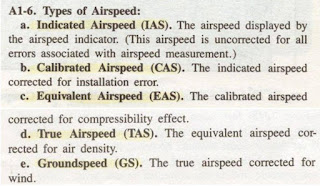Speed is the rate of change of position, or distance covered per unit of time. Airspeed gets input from Pitot tube and static air source.It is expressed in linear units per hour. As there are three main linear units, there are three main expressions of speed:
** Knots (kts) - nautical miles per hour
** Miles per hour (mph)
** Kilometres per hour (kph)
The airspeed indicator is used by the pilot during all phases of flight to maintain airspeeds specific to the aircraft type and operating conditions. Is used in addition to the Artificial horizon as an instrument of reference for pitch control during climbs, descents and turns.The airspeed indicator is also used in dead reckoning, where time, speed, and bearing are used for navigation in the absence of aids such as NDBs, VORs and GPS.
***Airspeed Indicator Error Examples:
-True Airspeed (TAS)True airspeed (TAS) of an aircraft is the speed of theaircraft relative to the air mass in which it is flying.














ليست هناك تعليقات:
إرسال تعليق